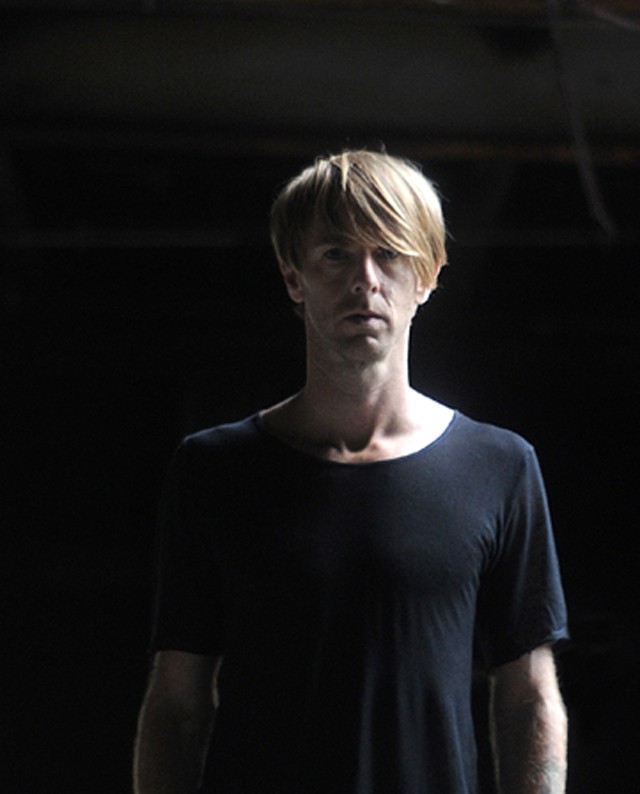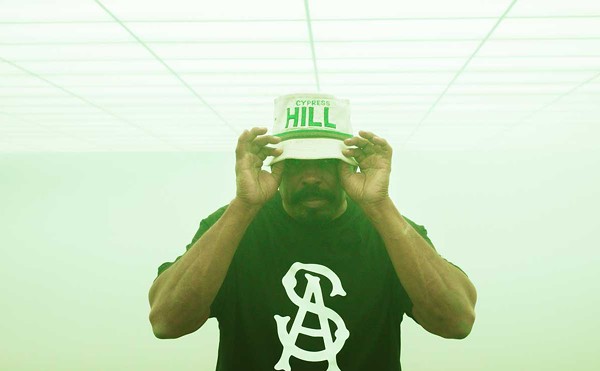The line stretches out the door of the Elysium Lounge and wraps around the corner in the cold Detroit November rain. Bass shakes the cement down the entire block, and earplugs are handed out as you make it to the door. Step inside and see Richie Hawtin manning the turntables in one of his famed DJ sets, megalith-size speakers looming to either side. Hawtin pushes the tempo and things heat up as smoke shoots from the sides of the club engulfing the pulsing crowd. You're bathed in a hypnotic bass rumble that contorts dancers who are stroboscopically frozen in the smoky darkness. You push through the bodies and head downstairs where calming ambient music matches the chilled-out blue light. It's a soothing juxtaposition of the upper level, but both create that same itch in the back of your brain: You wonder if you may have eaten some LSD and forgot. As the music bubbles, pings and hums, you realize that if you're asking yourself that question when you're stone sober, then Hawtin has done his job.
For the last seven years, the base for Hawtin's job — a handful of DJ sets as well as the re-emergence of his original work as the techno artist Plastikman — has been in Berlin, the "current center of techno." But in addition to his Windsor-based M-NUS label, he also keeps a pad here. It's the lone house on the block, an old fire station painted in the signature stark-white, jet-black and blood-red of his Plastikman artwork. Same thing inside, with carpet, tiles, heating vents, chairs, tables all continuing the same motif. Walking up to the side door in the distance you can see the river and beyond it Detroit which has loomed large in his life. As a 9-year-old immigrant from England to Canada, there was the excitement of his parents taking him across to the big city. As a teen, he recalled, there was the excitement of music, beginning with a band now forgotten by most.
"I remember it was a school night, and I must have been around 16 and sneaking out of my parents' house on a Wednesday going to St. Andrew's Hall to see an all-girl rock band called We've Got a Fuzzbox and We're Going to Use It, and I think I was nave enough that I was thinking they were talking about their equipment," Hawtin says with a chuckle and a glimmer of nostalgia for the long-ago late '80s in his eyes.
Early he gravitated to "the scary scene." Picture gothic Windsor mall kids wearing all black and lots of guyliner. But after repeated trips to Detroit warehouses and clubs like Taboo, Todd's and Bookies, he became immersed in the growing Detroit techno scene, a scene that grew around the Belleville Three — Kevin Saunderson, Juan Atkins and Derrick May. He would spend late nights and early mornings at the Shelter or the Majestic Theater every weekend listening to Blake Baxter. When the famed Music Institute opened its doors, Hawtin and his brother Matthew were waiting.
"I only went about a half dozen times. Before it even got to be popular it disappeared. It was really in the blink of an eye. It was really, for that moment, the center of the world for techno music. It was where you were hearing everything that was going to be big in Europe months from now. You're hearing test pressings, and Derrick and those guys were playing reel-to-reels of brand-new music. You heard things there that still haven't come out today. It was really, really incredible," Hawtin says.
Immersed in Detroit techno, Hawtin started getting gigs in Windsor, importing the Detroit sound. After pushing the tempo to breakneck speeds with releases like 1990's States of Mind with John Aquiviva — the first release on the duo's newly minted label Plus 8 (the fastest setting on a turntable) — in 1993 Hawtin slowed things down with the creation of Plastikman. Blending the punch of Detroit techno with a dark, creeping, psychedelic tinge, Plastikman created his signature sound. Now, 17 years, countless shows, festivals and BPM later, the story of Plastikman is in Arkives, a retrospective with 11 CDs, a DVD and a coffee-table book.�
"I'm not very nostalgic. I prefer to worry about new ideas and where I'm going, but putting Arkives together I had to go back through the history books and boxes of old tapes, and letters, and try to rebuild exactly in my head what had happened musically," Hawtin said. "It has let me repaint the whole picture of what Plastikman was and is, and retell that story to myself and then to other people so I can encapsulate it. Now through this process, I feel all of that history is much closer and much more a part of me again. I think that was what I was searching for in order to move forward and take new steps under the Plastikman name, or new steps as a DJ and as a label owner."
Arkives sums up Plastikman with all six studio albums and a slew of rarities, including live tracks and unreleased studio tracks. In addition, the collection features remixes of Plastikman cuts from artists who influenced him — including Carl Craig, Moby, Vince Clark from Erasure, members of Severed Heads.
With 1993's seminal Sheet One, Plastikman's earliest work takes you down into the highs and lows of an acid trip, from dark tunneling alleyways to the sound of a helicopter lift-off and everything in between. The cover was meant to look and feel like blotter paper and the music matched.
"I don't think I was really very experimental when I was a teenager. I didn't smoke, I drank a bit, but I didn't drink too much," Hawtin said. "But once I got sucked into electronic music, clubbing and going to late night parties, all that other stuff sort of came hand in hand. Acid was kind of the first thing I got into. What I like about acid is it seems to fire everything off. It kind of speeds up everything, even as it's slowing down time, it's kind of also speeding things and thoughts and ideas taking you to strange places and suddenly to another. I like that. I like that feeling."
At times, early Plastikman moves at breakneck speeds, 303 bass lines careening out of control, and at other times there's nothing but open rubbery space. With his next two albums, Musik and Artifacts (B.C), Hawtin strove to complete a trilogy of spacey, LSD-laced, bass-heavy wet dreams. During that time Hawtin recalls the infamously intense parties modeled after the Music Institute days.
"Sheet One and Musik bring me back to a time of old warehouses, late nights, dirty floors and plastic hanging from the ceilings," Hawtin said. "We were always trying to build a black box — for 200 people, 500 people, 2,000 people, whatever — where it was physical experience. It was undeniable. You would walk into the room and you would be sucked into this. You were either there or you would be running away scared. I just don't think everybody wanted to come to Detroit, our parties were pretty intense."
Hawtin wanted his parties to stand apart from what he saw as the cartoonishness of a mushrooming scene, what he calls the "candy raves." Around the country, raves were exploding into tens of thousands at parties, with fluff music overshadowed by lights and glam. Hawtin strove to get back to the basics that had inspired him with shows that "were supposed to be underground, music centric: Places where people would lose themselves in sound and lighting into a whole experience. It wasn't supposed to be about theme parks or fluffy castles, or day-glow colors. It was about music. Detroit's always been I think an underground music scene, it's always been a bit alternative. We wanted to be different, we didn't want to be like the rest of the country. We wanted it a little more visceral. Physical. Our main focus was to pummel and destroy people by sound and give them the best musical experience."
As Plastikman himself began to peak — at one point performing to over 20,000 revelers during London's legendary Glastonbury festival — musically he would then drive down an even darker path. After a troublesome border crossing, Hawtin wasn't allowed in the United States for more than a year, causing him to break off midway through recording what would become Artifakts (B.C) (as in Before Consumed) and begin work on the darker more ambient driven pieces like 1998's Consumed.
Hawtin also drifted away from Detroit, first throwing parties "up North" — he didn't say exactly where. The upstate secret parties would follow the dark introspective theme that Plastikman steered toward with 2003's Closer. By then Hawtin had moved to New York and then on to Berlin, where he currently lives.
"At the moment, I feel that that center [of electronic music] has kind moved to Berlin, I don't mean that just on a musical level. There's so much, so much density of people involved in electronic music in Berlin that it just makes it a central location right now," Hawtin said. "I think Detroit and Berlin are sister cities in a way. Both cities went through upheaval and very hard times and became a little bit, in some ways ... empty? But through the people that came there and live there, have created this incredible spirit and a lot of that spirit comes out through the music in a creative way."
Still for all Berlin offers, Detroit remains etched in his sound. "Every album is inspired by Detroit. Without Detroit Plastikman wouldn't be here," Hawtin said matter-of-factly, recounting sweat-soaked dance floors at the Bankle and Packard buildings as the quintessential "melting pots of creativity" where he tested out his early musical ideas with the tight-knit Detroit techno scene.
The group of friends who threw the infamous Voom and Bent Fabric parties at the underground hotspots were among the many who went on to create the Detroit Electronic Music Festival and later Movement, to which Hawtin returned this year with a Plastikman set to close the final night.� That was part of a slew of headlining dates as Plastikman returned to the fore after slowing down for a number of years, even hinting at the retirement of Plastikman. (The sporadic 2004-2007 singles are collected on the disc Nostalgik.)
"Plastikman was my answer to what I experienced in Detroit, so to come back 18 years later and do a performance of that material in Hart Plaza was one of those moments in life you'll never forget," Hawtin said "If someone would have said that to us 20 years ago, we would have been like, 'Wow, are you nuts?' You have to pinch yourself every time you're down there."
Like the Hart Plaza Plastikman set and the recent Windsor and Detroit DJ sets, Arkives brings Hawtin full circle.�
"Part of Arkives is connecting some of the dots that were missing. How I got from Sheet One to Musik, or how things developed after Consumed before Closer became an album," Hawtin said. "What it's supposed to do is bring everyone back to the beginning of Plastikman and take them back through the whole story, through words, images and sounds to give them an overview of everything I've been doing with Plastikman for the last 17 to 18 years."
And with Arkives completed, what's next for the man voted Best Live Act of 2010 by online electronic music rag Resident Advisor?
"I feel to be able to move forward with the Plastikman sound and have full freedom to go anywhere where it might take me, I need people to understand where it's been and where it's at now. That's in a way the purpose of Arkives. Where it will go?" Hawtin says, "I want it to go weirder and deeper."
Arkives is being pressed to order with all orders ending Dec. 31. Preview tracks and info at plastikman.com. Interview at vimeo.com/17846065.






